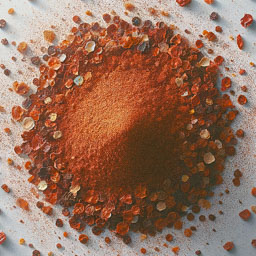
건조 고추 가루 from 인도
Be the first supplier featured in this market.
About this market
About
History
Chili peppers were introduced to India by Portuguese traders in the 16th century and quickly integrated into local food traditions. Commercial cultivation expanded substantially in the 20th century, particularly in Andhra Pradesh and Telangana. The government and agricultural universities played a critical role in developing new high-yielding and disease-resistant varieties to support both domestic needs and global trade.
Production Regions
- Andhra Pradesh & Telangana: Largest chili-producing belt, known for export-grade chilies.
- Karnataka & Tamil Nadu: Important for high-color and low-pungency varieties.
- Maharashtra: Major contributor of both open-pollinated and hybrid chilies.
- Madhya Pradesh & Rajasthan: Expanding areas with large-scale mechanized farms.
- Odisha & West Bengal: Minor production for local and Eastern India consumption.
Growing Conditions
- Altitude: Primarily grown in low to mid-altitude zones (100 to 800 m).
- Climate: Subtropical and tropical climates with distinct wet and dry seasons.
- Soils: Well-drained black cotton soil, red loamy soil, and sandy loam.
- Irrigation: Rainfed and canal/drip irrigation systems.
- Crop Cycle: 4 to 5 months depending on the variety and region.
Harvesting Process
- Harvesting: Hand-picked when pods turn fully red. Multiple pickings are common.
- Drying Methods: Sun drying on mats or concrete platforms; mechanical drying is increasing.
- Moisture Target: Reduced to ~8–10% for safe storage and export.
Cultivation Methods
- Farming Structure: Dominated by smallholder farms and cooperative growers.
- Crop Rotation: Commonly rotated with cotton, groundnut, or maize.
- Input Use: Moderate to high fertilizer and pesticide application.
- Pest Management: Focus on aphids, thrips, and anthracnose fungus.
Supply Chain
- Producers: Over 1 million farmers across major producing states.
- Processors: Grading, sorting, destalking, and powdering units located near growing hubs.
- Exporters: Mainly operate through Guntur and Byadgi markets; some are integrated with farmers.
- Traceability: Improved through eNAM (electronic National Agriculture Market) and contract farming.
Local Logistics
- Transport: Largely manual transport to mandis, then trucked to processing centers.
- Drying Infrastructure: Predominantly open sun drying; government subsidies support modern units.
- Export Ports: Chennai, Mumbai, Visakhapatnam, and Mundra.
Regulations and Certifications
- Regulatory Bodies: APEDA, Spices Board India.
- Certifications: FSSAI, AGMARK, Organic, GlobalG.A.P., and IPM for export markets.
Quality Standards
- Moisture Content: ≤10% for exports.
- Color Units: ASTA scale widely used; high-color types fetch premium prices.
- Capsaicin Content: Lab tested for Scoville Heat Units (SHU).
- Aflatoxin & Pesticide Residue Testing: Required for EU and US markets.
Trade Terms
- Exports (2023): Over 500,000 metric tons of dried chilies exported.
- HS Code: 0904.21 (Whole, dried, not crushed).
- Top Export Markets: China, Bangladesh, Thailand, Sri Lanka, US, Mexico, Malaysia, and EU countries.
Environmental Impact
- Pesticide Use: High in conventional farming; organic chili cultivation promoted in select zones.
- Water Use: Mainly grown in rainfed zones; drip systems gaining ground.
- Land Use: Crop rotations limit degradation; some monocropping issues in high-yield belts.
Social Impact
- Rural Employment: Chili farming supports millions, including women in harvesting and post-harvest.
- Women’s Role: Strong participation in sorting, grading, and manual processing.
- Farmer Income: Chilies provide one of the highest returns among short-cycle cash crops.
Uses
- Domestic Use: Masalas, pickles, curries, and snacks.
- Industrial Use: Powder, flakes, extracts, oleoresins for food, pharma, and cosmetics.
- Export: Whole dried pods, crushed chilies, and chili powder.
Variation
Guntur Sannam (S4)
High pungency and moderate color; major export variety.
Byadgi
Bright red color, mild pungency; preferred for its ASTA color value.
Teja
Extremely pungent; high Scoville units; used in crushed chili and powders.
273 Wrinkle
Highly wrinkled surface, popular in Chinese and Thai markets.
Mundu (Ramnad Gundu)
Round, low pungency, unique aroma; used in specialty spice mixes.
Kaddi
Long, thin variety with high pungency and sharp flavor; preferred in powdering.
Resham Patti
Smooth skin and medium heat; favored for table-use chili powder.
Jwala
Green-to-red variety used fresh and dried; mainly for domestic use.
Dabbi
Small, low-heat variety used in pickles and seasoning blends.
Sankar (Hybrid)
High-yield hybrid grown in Tamil Nadu and Maharashtra with good color retention.
Export of 건조 고추 가루 from 인도
Export overview
Export trend
Export transactions from 2024
Major exporters of 인도 건조 고추 가루 in 2024





Major importers of 인도 건조 고추 가루 in 2024





Historical export price trends
Verified manufacturers
/132x132/company-logo/a5/de/95/a5de950d83ac8b370b5fd9fd87849b11b9b71fd0/1000030040.png)
/132x132/company-logo/c2/6b/7d/c26b7d158008bb3a239ea2cde858d061bedf6517/Logo_PNG240_X_240.png)








